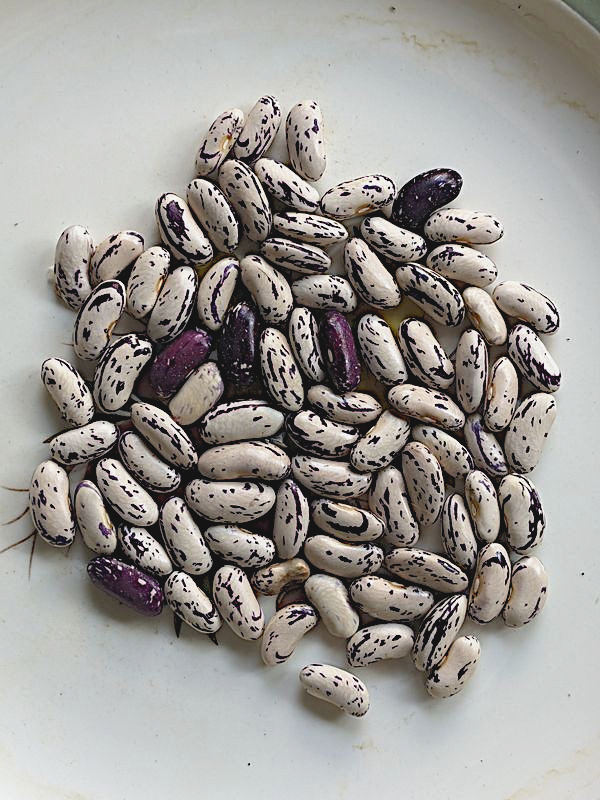By Richard Hebda
The short growing season in Canada demands rapidly maturing dry beans. Tina Davies of Emmerdale Eden Farm identified an early dry heritage bean from Quebec called Thibodeau de Comté Beauce in the best-of-ten dual purpose varieties article for Prince Edward Island (see https://heritagepotato.ca/richard/favourite-dry-dual-purpose-heritage-beans-from-emmerdale-eden-farm-prince-edward-island/). Our project goals are to find, test and make available dry bean varieties for northern gardens and Thibodeau fits the bill!
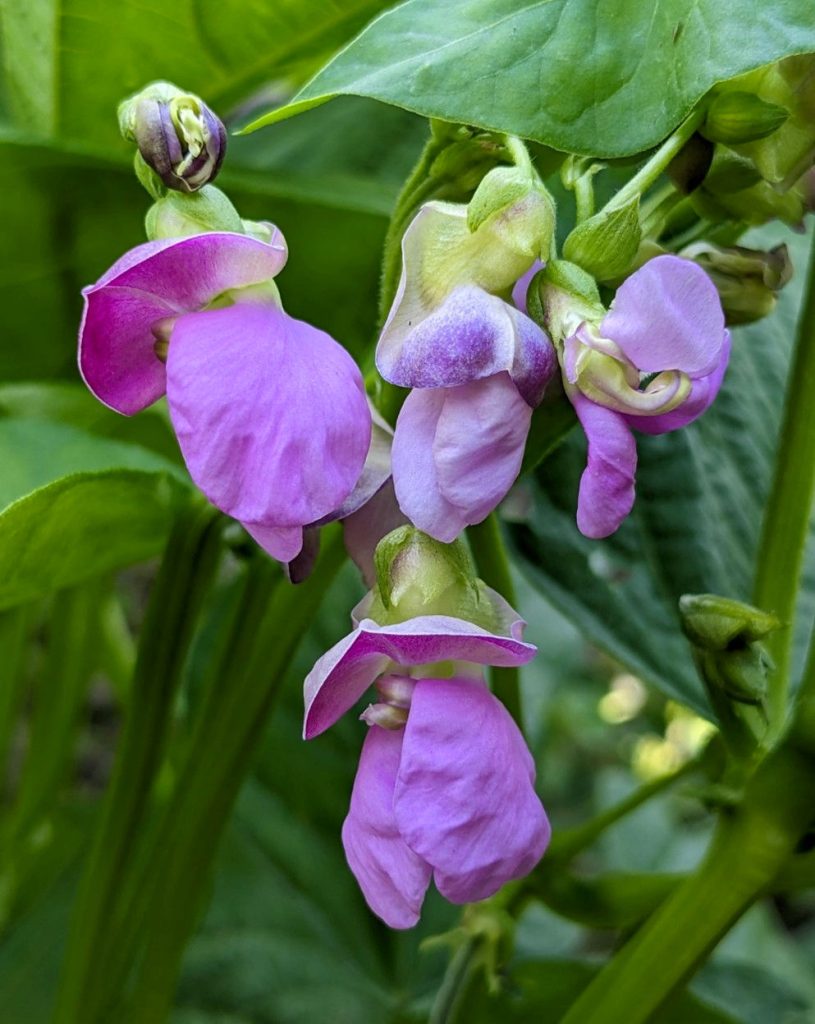
Thibodeau is a moderately tall and robust bush bean. Branching occurs mostly at the base with typical plants reaching 50 to 55cm (20-22”). Flowers are a stunning pink. Pods develop mainly in the upper part of the plant starting an even green, then quickly developing reddish purple marks. At maturity pods turn straw yellow marked prominently in attractive purple streaks. The suture along the back of the pod develops into a prominent sharp ridge. Pods are mostly straight though some curve slightly at the tip. Length ranges 15-19cm (about 6–7.5 “) with an average of about 17cm. The rounded pods are about 1.2cm high (1/2”) and slightly less wide. The point of the pod extends about 2 cm (3/4”) and is often curved at the tip.
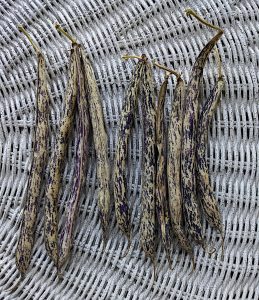
Typically, five (4-6) seeds fill the pod. Seeds have a shiny white base colour dotted by widely spaced purple markings many of which extend into narrow streaks. Markings are obviously purple not maroon as in typical Italian “borlotti” type beans. The bean seeds are strongly kidney-shaped. A long narrow white scar is surrounded by a yellow orange zone. The comparatively large and slightly flattened seeds range from 1.7-1.9cm long (3/4”), stand about 0.9cm (1/3”) high but are only 0.6cm (1/4”) thick.
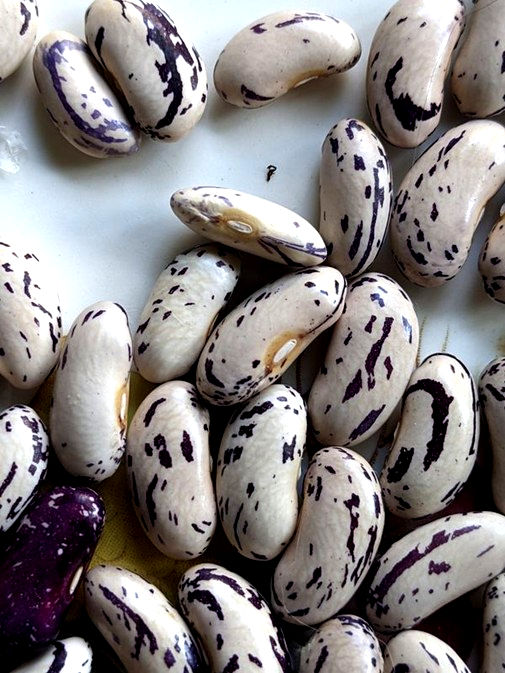
Using beans donated by Tina Davies I sowed twelve seeds of this variety in my garden under 6 mil clear plastic on April 25, 2025 in a raised bed. Germination took 9-15 days whereupon I removed the plastic and replaced it with row cloth. We sometimes experience mid May frosts, so the cover prevents damage, warms up the plants and speeds growth. The second true leaves were out by May 19 and tiny flower buds showed by May 26. Obvious purple buds were visible June 7 and Thibodeau was in full bloom on June 22 and even had tiny 1-3 cm (1/2-1”) thin pods. On July 2, the plants stood 40-50 cm (16-20”) tall and held the last of the flowers. At this time large 10 cm (4”) long striped/speckled pods covered the plants. The first dry pods occurred by the 3rd week of July with about 50% of them dry by July 29. Accordingly, a late April sowing yielded harvestable dry beans within 95 days. This interval is longer than listed by many sources and reported by us for PEI (70 days). However, I sowed early in the cool part of the spring to yield an exceptionally early dry bean harvest in late July. Almost certainly a typical late May sowing would yield dry beans in a shorter interval.
Some folks recommend using support for Thibodeau plants and I agree. Covered in a full crop of beans the bushes tend to lean and even fall over, sometimes even snapping at the base. Pods on leaning plants do not ripen as early as in erect plants. Also, some of the crowded or shaded pods seem not to fill with seed. So, give your plants lots of space and encourage them to grow erectly.
I harvested 0.35 kg from 1.4m of row resulting in a yield of 0.25 kg/m (1.8 lbs/ft). By comparison to other bush beans, especially those with smaller seeds this yield is good. You would need 4m (about 13’) of row to have lots of dry beans for winter cooking.
According to a Quebec seed supplier (terrepromise.ca) Thibodeau has a long Canadian history. Martin Roy of St-Zacharie, in Beauce, kept the seeds from his great, great grandmother Mrs. Thibodeau, from Beauceville in Beauce County. Possibly the variety has it origins in beans grown by the region’s Indigenous People.
Thibodeau can be eaten as a young snap bean, then later as a fresh shelled bean or used in the fully dry form. Thibodeau dry beans cook up superbly in baked bean dishes and combine well with other dry bean varieties. In a recent baked bean meal Tina Davies mixed pre-soaked Annie Jackson beans and Thibodeau de Comté Beauce’ in a slow cooker using the recipe at https://thishealthykitchen.com/slow-cooker-baked-beans/ . For her the dish was delicious, maybe a little spicy. Tina suggests reducing the maple syrup used in the recipe to 1/4 of cup.
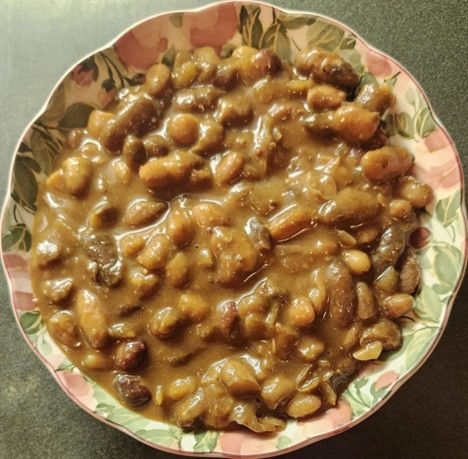
Thibodeau is one of Canada’s earliest dry beans and yields substantial crops. We recommend it for gardens across the country, and especially those regions with a short growing season.

